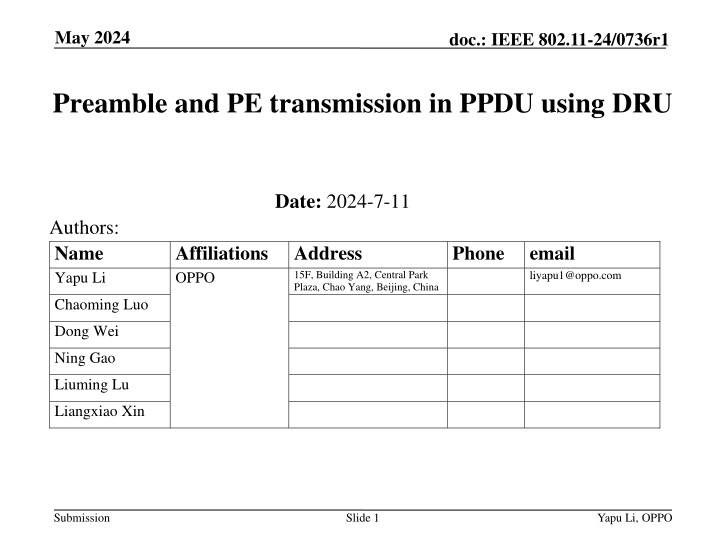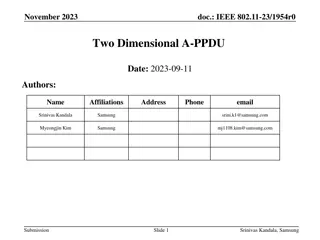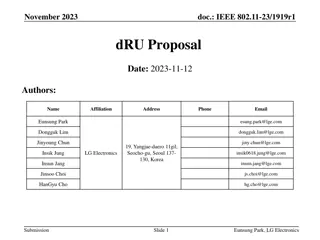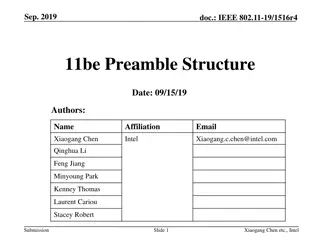Preamble and PE Transmission in PPDU Using DRU
The document discusses the transmission of Preamble and Physical End with the DRU technology in PPDU for IEEE 802.11 networks. It covers various aspects such as legacy preamble, UHR-STF, UHR-LTF, PE fields, and SIG transmission. The focus is on achieving compatibility and performance efficiency in Data transmission through appropriate configuration and consistency in signal transmission methods.
Download Presentation

Please find below an Image/Link to download the presentation.
The content on the website is provided AS IS for your information and personal use only. It may not be sold, licensed, or shared on other websites without obtaining consent from the author.If you encounter any issues during the download, it is possible that the publisher has removed the file from their server.
You are allowed to download the files provided on this website for personal or commercial use, subject to the condition that they are used lawfully. All files are the property of their respective owners.
The content on the website is provided AS IS for your information and personal use only. It may not be sold, licensed, or shared on other websites without obtaining consent from the author.
E N D
Presentation Transcript
May 2024 doc.: IEEE 802.11-24/0736r1 Preamble and PE transmission in PPDU using DRU Date: 2024-7-11 Authors: Name Yapu Li Affiliations OPPO Address 15F, Building A2, Central Park Plaza, Chao Yang, Beijing, China Phone email liyapu1@oppo.com Chaoming Luo Dong Wei Ning Gao Liuming Lu Liangxiao Xin Submission Slide 1 Yapu Li, OPPO
May 2024 doc.: IEEE 802.11-24/0736r1 Introduction The DRU consists of subcarriers spreading across a certain bandwidth to overcome PSD limitations. Most contributions focus on Data transmission by using DRU. In [1]-[7], there are many high level design principles of DRU, e.g. distributed BW, DRU size, puncturing, and hybrid mode, etc. In [8]-[15], DRU tone plan and pilot design are discussed. In this presentation, we will share our thoughts on Preamble and PE transmission in PPDU using DRU. Submission Slide 2 Yapu Li, OPPO
May 2024 doc.: IEEE 802.11-24/0736r1 Problem When DRU is introduced, how should PPDU s Preamble and PE be transmitted to match the performance of Data? We mainly focus on UL TB transmissions. L-STF L-LTF L-SIG RL-SIG UHR-STF UHR-LTF Data PE SIG Example: UHR PPDU Submission Slide 3 Yapu Li, OPPO
May 2024 doc.: IEEE 802.11-24/0736r1 Legacy preamble When PPDU using DRU transmission: L-STF, L-LTF, and L-SIG (RL-SIG) fields are duplicated over all the 20 MHz channels which overlap with the DRU assigned to the non-AP STA. For compatibility with legacy STA detection L-STF L-LTF L-SIG RL-SIG UHR-STF UHR-LTF Data PE SIG Example: UHR PPDU Submission Slide 4 Yapu Li, OPPO
May 2024 doc.: IEEE 802.11-24/0736r1 UHR-STF, UHR-LTF and PE When PPDU using DRU transmission: The set of tones used in UHR-STF and UHR-LTF sequences should be the same as the set of tones in the DRU used by the Data field. To ensure AGC and channel estimation consistent with DRU The PE field should be transmitted with the same average power as the Data field, and be commensurate with the tones of the occupied DRU(s) in the Data field. For implementation simplicity UHR-STF UHR-LTF PE L-STF L-LTF L-SIG RL-SIG Data SIG Example: UHR PPDU Submission Slide 5 Yapu Li, OPPO
May 2024 doc.: IEEE 802.11-24/0736r1 SIG (1/2) When DRU used in a UHR TB PPDU, for example, the SIG is U-SIG. The SIG field is duplicated over all the 20 MHz channels which overlaps with the DRU assigned to the STA. In order to be compatible with STAs which do not support DRU but can also decode SIG. Although in some cases, the Tx power of SIG is slightly lower than Data, we can appropriately reduce the Tx power of Data to match preamble s performance, and avoid introducing new PPDU format due to special processing of SIG. The max difference between Data and SIG is just 0.11dB, see appendix. SIG L-STF L-LTF L-SIG RL-SIG UHR-STF UHR-LTF Data PE Example: UHR PPDU Submission Slide 6 Yapu Li, OPPO
May 2024 doc.: IEEE 802.11-24/0736r1 SIG (2/2) f STA1 U-SIG L-STF L-LTF L-SIG RL-SIG U-SIG L-STF L-LTF L-SIG RL-SIG U-SIG L-STF L-LTF L-SIG RL-SIG U-SIG L-STF L-LTF L-SIG RL-SIG 20MHz UHR-STF, UHR-LTF, Data, PE t Example 1: 80MHz UHR TB PPDU using DRU Submission Slide 7 Yapu Li, OPPO
May 2024 doc.: IEEE 802.11-24/0736r1 Summary L-STF, L-LTF, and L-SIG (RL-SIG) fields: Duplicated over all the 20 MHz channels which overlap with the DRU assigned to the non-AP STA. The used tones are continuous. SIG field: Duplicated over all the 20 MHz channels which overlap with the DRU assigned to the user, assuming that DRUs are only used in UL TB and UL non-TB SU transmissions. UHR-STF, UHR-LTF, and PE fields: The set of tones used in UHR-STF/LTF sequences and PE should be the same as the set of tones in the DRU used by Data field. Submission Slide 8 Yapu Li, OPPO
May 2024 doc.: IEEE 802.11-24/0736r1 References [1] 11-23-1919-00-00bn-dRU Proposal [2] 11-23-1988-02-00bn-High Level Thoughts on DRU Design [3] 11-23-2020-01-00bn-High-Level Perspectives on Distributed Tone RU for 11bn [4] 11-23-2200-03-00bn-Distribution bandwidth of DRU [5] 11-24-0014-00-00bn-Further Thoughts on dRU [6] 11-24-0400-00-00bn-Hybrid PPDU and Distribution Bandwidth for DRU [7] 11-24-0520-01-00bn-Discussion on DRU [8] 11-23-2021-01-00bn-Principle and Methodology for dRU Tone Plan Design [9] 11-23-2031-02-00bn-Data Tones Grouping in Tone-Distributed RUs [10] 11-24-0078-01-00bn-A dRU Design Approach for 20 MHz [11] 11-24-0401-00-00bn-Multiple DRU Follow Up [12] 11-24-0402-00-00bn-20 MHz Tone Plan and Pilot Design for DRU [13] 11-24-0468-01-00bn-DRU Tone Plan for 11bn [14] 11-24-0476-01-00bn-Tone Plan Design for Distributed RU [15] 11-24-0501-01-00bn-Pilot Design Considerations for dRU Submission Slide 9 Yapu Li, OPPO
May 2024 doc.: IEEE 802.11-24/0736r1 Appendix Tx Power (dBm) Gap=UHRmodulated PreUHRmodulated (dB) RU Size Field DRU BW20 DRU BW40 DRU BW80 DRU BW20 DRU BW40 DRU BW80 Pre-UHR modulated* 11.11, 11.43 14.12, 14.44 17.13, 17.45 RU26 -0.90, -1.22 -0.90, -1.22 -3.91, -4.23 UHR modulated 10.21 13.22 13.22 Pre-UHR modulated 11.11, 11.43 14.12, 14.44 17.13, 17.45 RU52 0.35, 0.03 -0.90, -1.22 -0.90, -1.22 UHR modulated 11.46 13.22 16.23 Pre-UHR modulated 11.11, 11.43 14.12, 14.44 17.13, 17.45 RU106 0.43, 0.11 0.43, 0.11 -0.82, -1.14 UHR modulated 11.54 14.55 16.31 Pre-UHR modulated / 14.12, 14.44 17.13, 17.45 / RU242 0.34, 0.02 -0.24, -0.56 UHR modulated / 14.46 16.89 / Pre-UHR modulated / N/A 17.13, 17.45 / / RU484 0.34, 0.02 UHR modulated / N/A 17.47 / / Note 1: PSD = -1dBm/MHz *Note 2: The two values in the pre-UHR modulated field correspond to the L-STF/L-LTF field and the L-SIG/U-SIG/UHR-SIG field, respectively. Since the L-STF/L-LTF field uses 52 tones, L-SIG/U-SIG/EHT-SIG field uses 56 tones. Submission Slide 10 Yapu Li, OPPO
May 2024 doc.: IEEE 802.11-24/0736r1 SP 1 Do you agree to add the following text to the TGbn SFD? If a DRU for a PPDU occupies more than one 20 MHz channel, then the L-STF, L-LTF, L-SIG, and RL-SIG fields are duplicated over all the 20 MHz channels which are occupied by the DRU. Y/N/A: // Submission Slide 11 Yapu Li, OPPO
May 2024 doc.: IEEE 802.11-24/0736r1 SP 2 Do you agree to add the following text to the TGbn SFD? If a DRU for a PPDU occupies more than one 20 MHz channel, then the SIG field is duplicated over all the 20 MHz channels within a given 80MHz frequency subblock which are occupied by the DRU. The content of SIG field between different 80MHz frequency subblocks is TBD. Note: The SIG field is U-SIG in a UHR TB PPDU Y/N/A: // Submission Slide 12 Yapu Li, OPPO
May 2024 doc.: IEEE 802.11-24/0736r1 SP 3 Do you agree to add the following text to the TGbn SFD? The set of tones used by the PE field should be same as the set of tones in the DRU used by the Data field. Y/N/A: // Submission Slide 13 Yapu Li, OPPO























